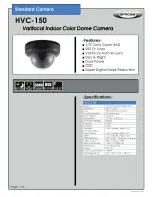
OPERATING MANUAL
36
ST 401 ‘CAYMAN’ NLJD
37
The
ST 401 ‘Cayman’ NLJD
makes it possible to listen to demodulated signals while probing
with six different frequency combinations. Each combination, indicated by LEDs on the CH bar,
is suited to deal with a particular category of nonlinear objects. Upon activation of the AUDIO
mode, frequency combination 1 is set by default; it is meant for probing semiconductor content
and, as a rule, gives good results in identifying active radio-transmitting and sound-recording
devices.
Frequency combination 2 is used to analyse return signals from MOM (metal-oxide-metal)
structures.
The remaining four combinations are auxiliary. Their use is advised when responses have been
observed in search modes on the red LEVEL multi-segment gauge, yet probing with combination
#1 has rendered no definitive findings.
Table 3
shows correspondence between frequency combinations and responses observed in
search modes.
Table 3
Frequency combinations can be switched over with SEL buttons (Fig. 7: 4 and 5).
Table 4
shows typical results of analysing targets with nonlinear properties.
Table 4
Type of probed
target
Optimum frequency
combination
Sounds in the
presence of
mechanical impact
or test sound
Sounds in the
absence of
mechanical impact
or test sound
MOM-structure
2
crackling, creaking
none
active electronic
devices (unencoded
transmission channel)
1 (3–6)
audible response to
tapping or test sound
sounds of the
environment
active electronic
devices (encoded
transmission channel)
1 (3–6)
peculiar signals
caused by the
operation of
the device and
independent of
sounds in the
environment
peculiar signals
caused by the
operation of
the device and
independent of
sounds in the
environment
indication on CH bar
freq. combination #
1
2
3
4
5
6
LEVEL gauge # in search mode
1
2
1
1
1
1
Table 4 (Continued)
Type of probed
target
Optimum frequency
combination
Sounds in the
presence of
mechanical impact
or test sound
Sounds in the
absence of
mechanical impact
or test sound
inactive electronic
devices
1 (3–6)
none
none
active electro-
mechanic or
mechanic appliances
1–6
crackling, creaking
peculiar signals
caused by the
operation of
the device and
independent of
sounds in the
environment
When listening to demodulated signals, it is recommended to use headphones. Sound volume
is adjustable with a variable resistor (Fig. 6: 4).
Recommendations
Any response observed on the red bar (or on both red and blue bar simultaneously) should be
analysed in the audio mode with the use of a test sound source. If a response has been observed
on the blue bar, it is advisable to perform audio analysis with the frequency combination # 2,
subjecting the target area to mechanical impact (tapping). While probing, it is advisable to change
gradually the distance between the antenna and target within 5–100 cm range.
Switching to other modes
By pressing MODE it is possible to return to the search mode from which the AUDIO mode
has been entered into.
2.7. Program Updates
ST 401 ‘Cayman’
has a processor that operates in accordance with the program firmware that
is pre-installed by the manufacturer company. Over time the firmware gets refined and newer
versions get released, that can be installed through the micro-USB port.
What is my firmware version?
In order to find out what firmware version is currently installed on your
ST401
, press and hold
the AUDIO button for 3 seconds. The three LEVEL gauges (Fig. 4: 4, 5 and 6) will light up, with
the number of lit LEDs indicating the current version in the format ‘R.B.W’ (red, blue, and white).
For example, if 1 red, 2 blue, and 5 white LEDs are lit up, then your current version is 1.2.5.
To escape from this mode, press any button.
Firmware update procedure
The newest firmware version, with issues sorted out or features added, can be downloaded
from http://spymarket.com/ (‘ST 401 CAYMAN’ section) and installed through the micro-USB
port with the installer enclosed with the update files.




































